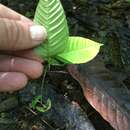Biology
provided by Arkive
The light red meranti flowers only once every two to five years, with nearly all the light red merantis in a region flowering at the same time (3) (5). The small flowers, which each bear both male and female reproductive parts, open in the evening and are visited by common flower thrips (Thrips and Megalurothrips species), which are attracted to the flower's strong scent (5). Following flowering and pollination by the thrips, the fruit is produced. The winged fruit is dispersed by the wind, but due to the structure of the wings, they spin fairly quickly to the ground, and are rarely carried more than 50 metres away from the parent tree (3) (5). The light red meranti is said to grow fast for the first twenty years (2), but is does not reach reproductive maturity until an age of 25 (5).
Like all dipterocarp trees, the light red meranti produces an oily aromatic resin, known locally as dammar, which is thought to help protect the tree against attacks by bacteria, fungi and animals. The leaves also contain tannins, a bitter-tasting substance which makes this tree unappealing to any leaf-eating animal such as the orang-utan and proboscis monkey (3).
Conservation
provided by Arkive
The light red meranti is known to occur in some forest reserves (1).
Description
provided by Arkive
This tall tree, which has a copper-coloured crown and shallowly ridged, greyish-brown bark, is one of the many dipterocarp species that dominant the forests of Asia (2) (3) (4). The trunk, which is buttressed to a height of about 1.5 metres, rises up to a cauliflower-shaped crown of leaves that appears pale coppery, yellow-brown from below. The individual leaves are leathery and measure up to 14.5 centimetres long. The upper surface may be smooth or with a sparse covering of grey brown hairs on the surface, and is reddish-brown, purplish-brown or brown when dry. The lower surface of the leaf is a dull greyish-brown or yellowish-brown, rough to the touch, and densely covered with short yellow-brown hairs. The flowers of the light red meranti are small with yellow petals (2). The fruit is a single-seeded nut enveloped in a covering bearing three long and two shorter wings (2) (3).
Habitat
provided by Arkive
The light red meranti inhabits dipterocarp forest on lower hill slopes and valleys, primarily below 700 metres (2). It grows on a range of soils, but does not tolerate waterlogged areas (4).
Range
provided by Arkive
Distributed from southern Thailand, through Peninsular Malaysia and Sumatra, to Borneo (2) (5).
Status
provided by Arkive
Classified as Endangered (EN) on the IUCN Red List (1).
Threats
provided by Arkive
Light red meranti has been heavily exploited for its valuable timber, leaving populations of this threatened tree drastically reduced (1).

